Description
We have been using Cera-Tec in our Jeeps for over a year now. We swear by this stuff! Liqui Moly is the king of lubricants and additives, and the time we have spent with them at SEMA has confirmed they know their stuff.
We have seen a gas mileage increase, quieter-running engine, and lower oil and coolant temperatures on multiple vehicles. Lower friction obviously means more power, too, although we have not measured it.
Obviously we cannot guarantee your results, but from what we have personally experienced, we are believers! We always encourage research, especially on something you are putting in your expensive engine, so please do research all you like, and if/when you are ready, we are happy to sell it to you for use with your kit.
Below is an incredibly detailed and well-done article from Team-BHP regarding real world results of Cera-Tec (which have confirmed what we have experienced in our own vehicles):
Hello BHPians!
 As promised, here is my review on the Liqui Moly CeraTec, which is an oil additive that claims to improve NV levels along with mileage & also claims to increase engine life. I switched from Shell Helix to Liqui Moly TopTec 4100 on my Skoda Laura a few months back (Done a review on it here) and it has since then improved/multiplied my trust on the Liqui Moly brand. I was planning on adding CeraTec & some of you guys suggested that I must use it. Now, oil additives are one of the highly debated topics among car guys. Many say that they don’t really work, yet an equal (or more) number of guys claim that they do work. I have never used any oil additive on any of our cars before & honestly I was among the people who think that oil additives are total bullsh*t like blinker fluid because of 2 main reasons :
As promised, here is my review on the Liqui Moly CeraTec, which is an oil additive that claims to improve NV levels along with mileage & also claims to increase engine life. I switched from Shell Helix to Liqui Moly TopTec 4100 on my Skoda Laura a few months back (Done a review on it here) and it has since then improved/multiplied my trust on the Liqui Moly brand. I was planning on adding CeraTec & some of you guys suggested that I must use it. Now, oil additives are one of the highly debated topics among car guys. Many say that they don’t really work, yet an equal (or more) number of guys claim that they do work. I have never used any oil additive on any of our cars before & honestly I was among the people who think that oil additives are total bullsh*t like blinker fluid because of 2 main reasons :
Every manufacturer wants their engine to be quiet & smooth – they’ll try their max to improve these through less expensive, more obvious things like better lubricants & bearings.
Adding something to the oil will modify its properties – may increase/decrease the viscosity – I always thought this is bad for the engine because it drifts away from the manufacturer specification
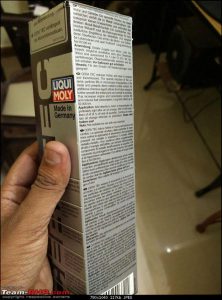 Liqui Moly CeraTec is one of the first names that come up if you do a search on Google for ‘engine oil additive’. It is quite famous among enthusiasts & is commonly added while changing the engine oil. It is available here in India at a cost upward from about Rs.2500/- depending on the source. I was planning on adding it along with the oil, but it wasn’t available in stock with Land Rover Labs(from where I bought Liqui Moly TopTec 4100 oil) when I bought the oil. Didn’t try other sources & was delayed because I wanted to see how the oil performed. Also, wanted to make sure that the smoothness & responsiveness I felt after the oil change wasn’t just placebo. The car has now clocked around 7100KMs after the oil change, you can find more on my thoughts here. I’m particularly interested in knowing what CeraTec can do on top of the improved NV levels after switching over to TopTec 4100. I wasn’t expecting miracles, but after reading all the praises about the product on the interwebs, I was keen on trying this.
Liqui Moly CeraTec is one of the first names that come up if you do a search on Google for ‘engine oil additive’. It is quite famous among enthusiasts & is commonly added while changing the engine oil. It is available here in India at a cost upward from about Rs.2500/- depending on the source. I was planning on adding it along with the oil, but it wasn’t available in stock with Land Rover Labs(from where I bought Liqui Moly TopTec 4100 oil) when I bought the oil. Didn’t try other sources & was delayed because I wanted to see how the oil performed. Also, wanted to make sure that the smoothness & responsiveness I felt after the oil change wasn’t just placebo. The car has now clocked around 7100KMs after the oil change, you can find more on my thoughts here. I’m particularly interested in knowing what CeraTec can do on top of the improved NV levels after switching over to TopTec 4100. I wasn’t expecting miracles, but after reading all the praises about the product on the interwebs, I was keen on trying this.
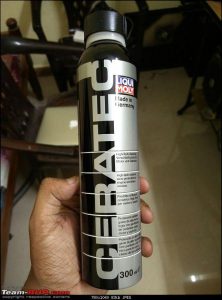
Bought CeraTec from Land Rover Labs, they’re one among the authorised Liqui Moly(and a host of other performance & detailing product brand) distributors in India. Like before, the package arrived at my home in a neatly packed box in just 2 days, all the praise to LRL Motors! CeraTec claims to be based on a micro ceramic compound that sticks to metal parts, creating a lasting lubricating effect. On their product specification document, they’ve mentioned that CeraTec is based on Hexagonal Boron Nitride(Read more here: https://en.wikipedia.org/wiki/Boron_…e#Hexagonal_BN) which is used in lubricants & in cosmetics! The container looks & feels awesome(ah the Germans!) for an oil additive, it comes in an aluminium bottle of 300mL which is for use with 5L of oil. The package also comes with a sticker inside, which is used to note down the reading on the ODO when adding CeraTec, which is quite nice. I stuck it along side of a warning sticker on the car.
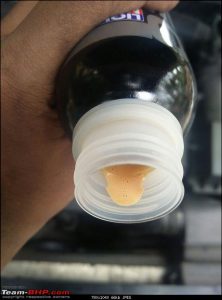
Adding it is straight forward, bring the engine up to temperature, turn the engine off, remove the oil cap and empty the bottle in. I was pretty much sure that I won’t be able to notice any difference at least for a few hundered(or thousand) kilometres. Hence, thought about measuring the before & after NV levels so that a scientific comparison can be carried out instead of just sticking to my senses!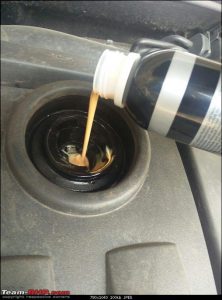
Test Setup
Measurement was carried out using the Android app iNVH by Bosch running on my One Plus 2. It is a free app (For advanced features like FFT plot and all, you’ll have to spend Rs.650, which wasn’t necessary for my purpose). The app uses various sensors built into the phone to carryout the measurements. This is not a perfect setup to test out the NV levels, but it gets the job done & accurate enough for this.
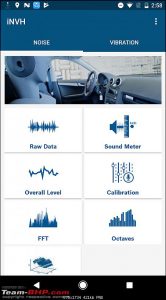 Sensors, especially the high precision gyro & dual microphones on the phone makes the setup pretty accurate for the purpose of measuring engine noise and vibration. For measuring the NV levels, the phone was stuck to the steering wheel using this double sided tape which is not thick enough provide damping, which could mess up the readings. Measurements should be accurate with the setup. The iNVH app has a data logging(recording) feature builtin which makes it easy to plot the data later on a laptop. Generated data was plotted using DataGraph, a Mac App for charting & graphing.
Sensors, especially the high precision gyro & dual microphones on the phone makes the setup pretty accurate for the purpose of measuring engine noise and vibration. For measuring the NV levels, the phone was stuck to the steering wheel using this double sided tape which is not thick enough provide damping, which could mess up the readings. Measurements should be accurate with the setup. The iNVH app has a data logging(recording) feature builtin which makes it easy to plot the data later on a laptop. Generated data was plotted using DataGraph, a Mac App for charting & graphing.
Measurement
The measurements were carried out while:
The engine was at its operating temperature, 90 degrees.
The AC was kept completely off since it will affect NV levels when the load on compressor changes(Which is quite often since the car has a climatronic unit which keeps on running the compressor adjusting the load).
All windows/doors closed (It was an oven!!)
Head unit was off
Car was on a flat concrete floor with 34bar pressure on every tyre with hand brake.
Ambient noise outside the car was almost nil (Lazy Saturday morning to the rescue!)
Phone was stuck to the centre of the steering wheel running iNVH app
‘After’ readings were taken after adding CeraTec and idling the engine for about 5minutes.
Results
Noise & Vibration readings were taken before and after adding CeraTec. I didn’t feel any difference in noise at the time of measuring. But the findings are quite interesting:
Noise
Even though I couldn’t sense any difference in the noise level, iNVH was able to pick up a very slight change. Noise sample rate was 10.79 samples/second
Before CeraTec, the peak noise level recorded in a period of about 32 seconds was 46.66dB and the lowest recorded level was 42.62dB – the cabin is pretty quiet. While a bird call is around 44dB(Source), this cabin does a very good job at keeping the noise levels low. Checkout the plots below(Black line along the centre is a LOESS Curve):

After CeraTec, the peak noise level recorded in the same period of about 32 seconds was 46.5dB and the lowest recorded level was 42.45dB. CeraTec managed to lower the upper level by 0.16db & the lower level by 0.17dB – pretty much the same value.
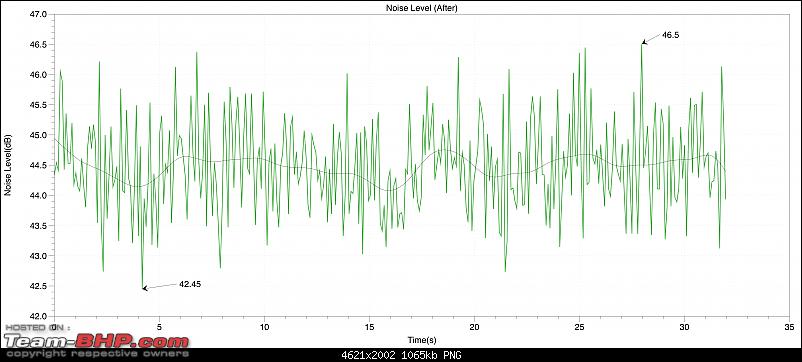
Vibration
Now this was noticeable right after adding CeraTec, though the difference wasn’t that significant then, I could feel a slight change in the vibration that I’m used to while holding the steering wheel. Felt like the vibrations were a bit muffled, just like sensing the vibration of a phone that is in a thick flip case. Vibration sample rate was 202.47/second. Vibration along the coordinate axes are in m/s2, if anyone is interested unit conversions & the math behind vibration measurement, go through this: http://blog.prosig.com/2011/09/05/vi…-displacement/.
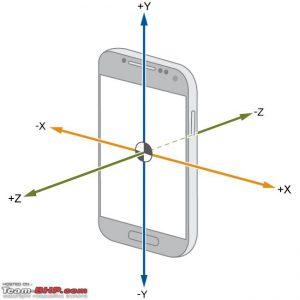 This image should make a bit of sense about the coordinate axes with respect to a phone. The phone is stuck to the steering wheel on top of the logo – Ideally(Steering kept steady without moving), moving the car forward or backward will result in large changes in the z-axis while humps would change the y-axis & sideways movement should reflect on the x-axis. There could be measurement errors since the steering axis is not exactly straight & the phone was mounted at a slight angle.
This image should make a bit of sense about the coordinate axes with respect to a phone. The phone is stuck to the steering wheel on top of the logo – Ideally(Steering kept steady without moving), moving the car forward or backward will result in large changes in the z-axis while humps would change the y-axis & sideways movement should reflect on the x-axis. There could be measurement errors since the steering axis is not exactly straight & the phone was mounted at a slight angle.
My car has a straight inline 4 engine with the flywheel mounted(and rotating) in parallel with the wheel. Hence, with our mounting setup, the flywheel’s axle is roughly in parallel with our phone’s x-axis. According to right hand rule for torque(http://hyperphysics.phy-astr.gsu.edu/hbase/tord.html), our z-axis should record higher acceleration values since the force due to the flywheel is acting that way. It was evident when I plotted the values.
Before CeraTec, the peak x-axis acceleration recorded for a period of 1 second was 0.8057m/s2, y-axis acceleration recorded was 0.6681/s2 and z-axis acceleration recorded was 1.42m/s2. While the trough recordings for the axes were -0.6768m/s2, -0.4328m/s2 and -1.215m/s2 respectively.
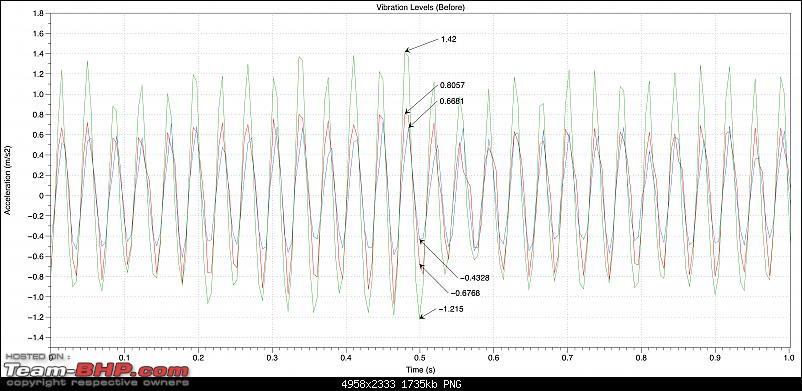
After CeraTec, the peak x-axis acceleration recorded for a period of 1 second was 0.7096m/s2, y-axis acceleration recorded was 0.6242m/s2 and z-axis acceleration recorded was 1.392m/s2. While the trough recordings for the axes were -0.7287m/s2, -0.516m/s2 and -1.136m/s2 respectively.
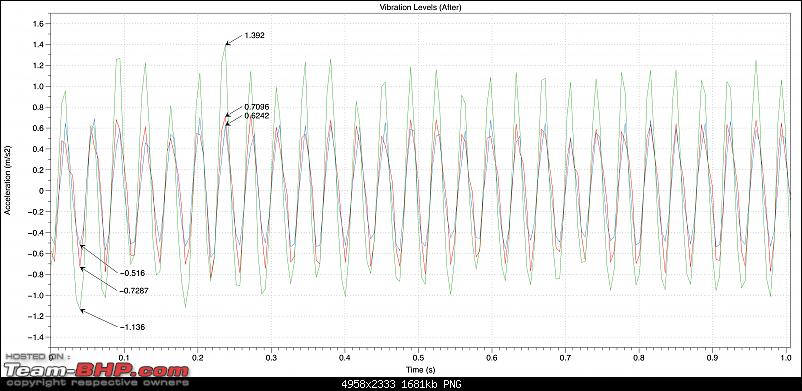
Definitely lower values after adding CeraTec. Though by small numbers, this can be felt.
Engine vibrations were reduced noticeably & after a quick test drive, it was even more evident. I drove about 20 kilometres post adding CeraTec. I know it isn’t much, but the difference in vibration levels are noticeable. This has definitely given me confidence in CeraTec, I’m planning on ordering 3 more bottles for use in other cars at home. Would I recommend this? I am a converted believer of CeraTec & Land Rover Labs, of course I will!
I’ll be posting updates on this thread as I crunch more kilometres with it, I’m interested in long term effects of the product on fuel economy & the noise level.
For those who are interested in the raw data from iNVH in CSV format, you can find them in this ZIP file: CeraTec_NV_data_CSV.zip
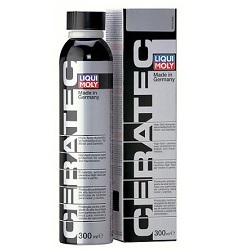

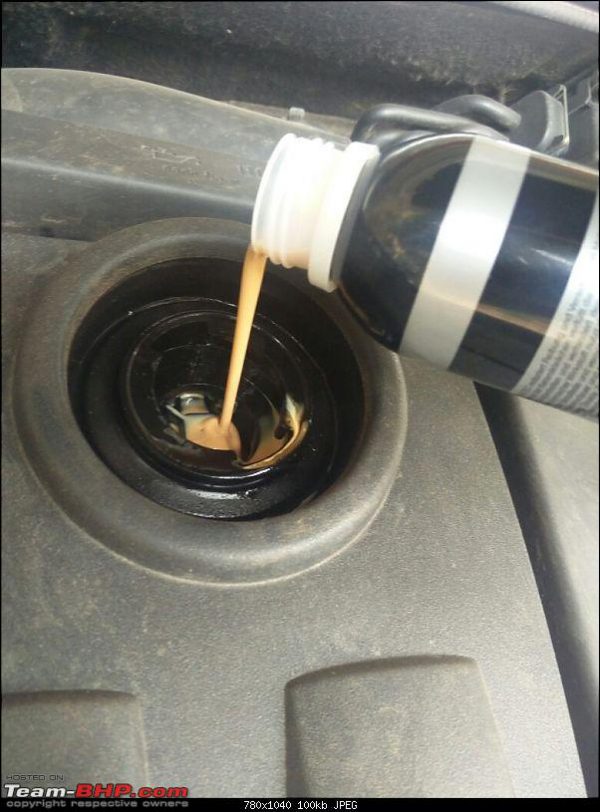
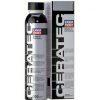
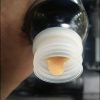
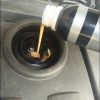
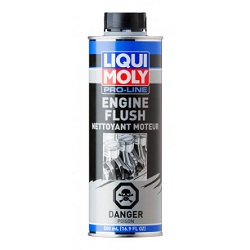
Reviews
There are no reviews yet.